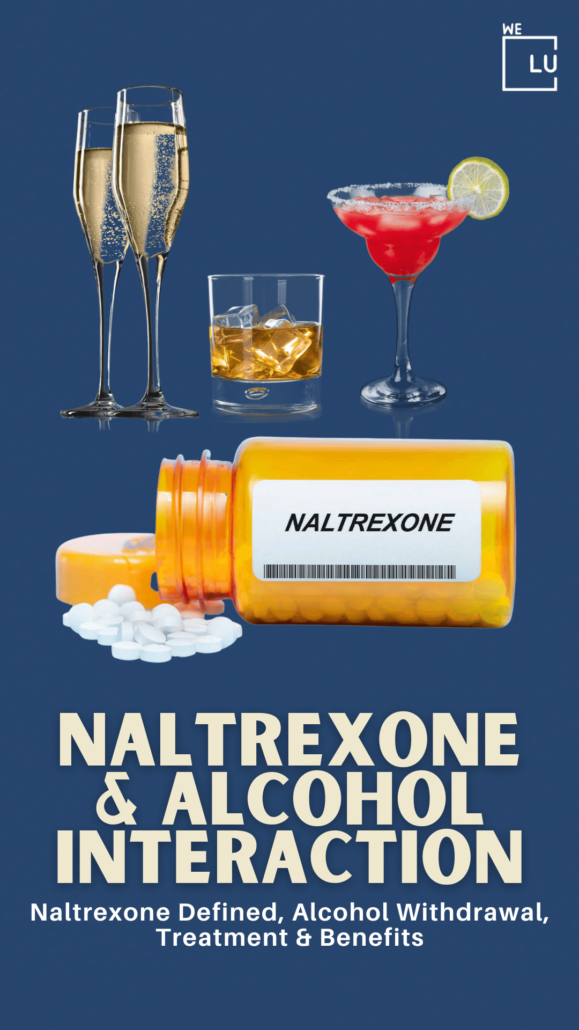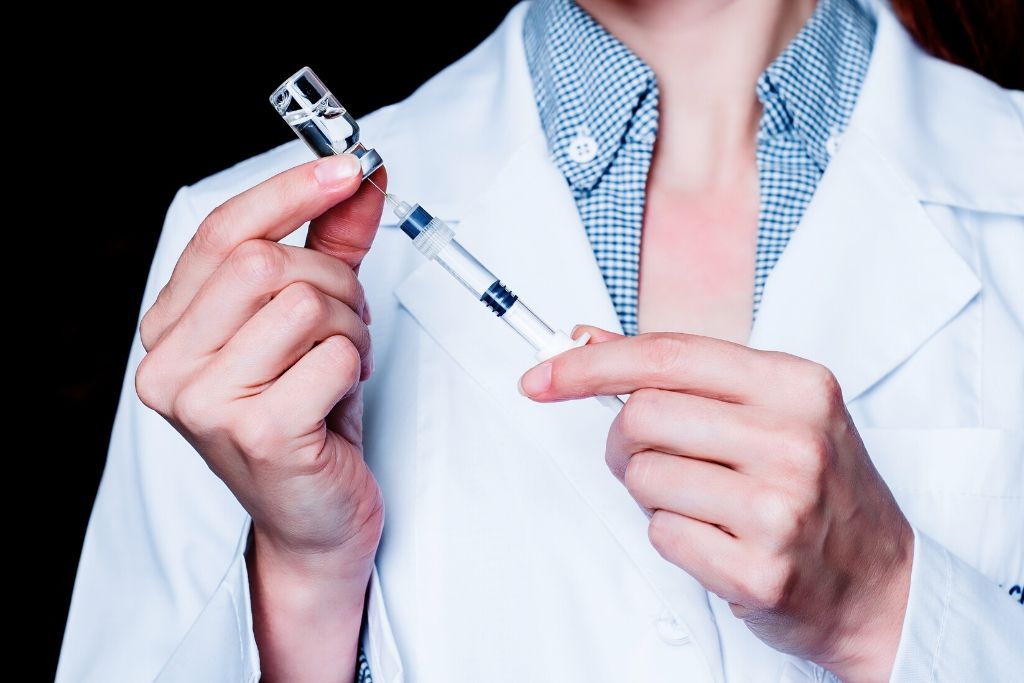What is Naltrexone?
Naltrexone is a medication approved by the Food and Drug Administration (FDA) to treat both opioid use disorder (OUD) and alcohol use disorder (AUD) as a medication-assisted treatment (MAT) option. Naltrexone can be prescribed and administered by any practitioner licensed to prescribe medications and is available in a pill form for alcohol use disorder or as an extended-release intramuscular injectable for either alcohol or opioid use disorder.
A Risk Evaluation and Mitigation Strategy (REMS) is required for the long-acting injectable formulation to ensure that the benefits of the drug outweigh its risks. The pill form can be taken daily for AUD, but the extended-release injectable formulation is approved for the treatment of OUD. The pill form is taken daily and the extended-release injectable is administered every four weeks, or once a month, by a practitioner.
Naltrexone is one component of a comprehensive treatment plan, which includes counseling and other behavioral health therapies to provide patients with a whole-person approach. Naltrexone is not a recommended MAT option for anyone younger than 18 years of age, or for patients experiencing other health conditions. [1]
Naltrexone and Alcohol Use
When starting naltrexone for AUD, patients must not be physically dependent on alcohol or other substances. To avoid strong side effects such as nausea and vomiting, practitioners typically wait until after the alcohol detox process before administering naltrexone.
Naltrexone binds to the endorphin receptors in the body and blocks the effects and feelings of alcohol. Naltrexone reduces alcohol cravings and the amount of alcohol consumed. Once a patient stops drinking, taking naltrexone helps patients maintain their sobriety. Naltrexone MAT treatment lasts for three to four months. Practitioners should continue to monitor patients who are no longer taking naltrexone.

Naltrexone and Alcohol Interaction
Naltrexone has been best studied as a treatment for alcoholism. Naltrexone has been shown to decrease the amount and frequency of drinking. It does not appear to change the percentage of people drinking. Its overall benefit has been described as “modest”.
Acamprosate may work better than naltrexone for eliminating drinking, while naltrexone may decrease the desire for alcohol to a greater extent.
The Sinclair method is a method of using opiate antagonists such as naltrexone to treat alcoholism. The person takes the medication once, about an hour before drinking, to avoid side effects that arise from chronic use. The opioid antagonist is thought to block the positive-reinforcement effects of alcohol and may assist the person to stop or reduce drinking.
Side Effects of Naltrexone and Alcohol
Common side effects of naltrexone and alcohol may include:
- Nausea
- Sleepiness
- Headache
- Dizziness
- Vomiting
- Decreased appetite
- Painful joints
- Muscle cramps
- Cold symptoms
- Trouble sleeping
- Toothache
- Severe reactions of the body to the mixed Naltrexone and alcohol as well as at the site of injection. Severe injection site reactions are possible, including tissue death. Some of these reactions have required surgery. Patients should call their practitioner right away if they experience any of following issues of concern at the injection site:
- Intense pain
- The area feels hard
- Large area of swelling
- Lumps
- Blisters
- An open wound
- A dark scab
- Patients should contact their practitioner about any reaction at an injection site that is concerning, gets worse over time, or does not get better within two weeks.
- Liver damage or hepatitis is possible with Naltrexone and alcohol. Patients should tell their practitioner about any of the following symptoms during treatment:
- Stomach area pain lasting more than a few days
- Dark urine
- Yellowing of the whites of your eyes
- Tiredness
- Practitioners may need to stop treatment using naltrexone if patients develop signs or symptoms of a serious liver problem
- Depressed mood
- Pneumonia
- Serious allergic reactions
- Skin rash
- Swelling of face, eyes, mouth, or tongue
- Trouble breathing or wheezing
- Chest pain
- Feeling dizzy or faint
These are not all the side effects of naltrexone and alcohol. For more information, patients should talk to their practitioner or pharmacist. Patients should tell their practitioner about any side effects that are bothersome or do not go away.
Naltrexone and Alcohol Withdrawal
Naltrexone will help you avoid using drugs and alcohol, but it will not prevent or relieve the alcohol withdrawal symptoms that may occur when you stop using these substances. Instead, naltrexone may cause or worsen withdrawal symptoms. You should not take naltrexone if you have recently stopped using opioid medications or opioid street drugs and are now experiencing withdrawal symptoms. [2]
You should know that people who overuse drugs or alcohol often become depressed and sometimes try to harm or kill themselves. Receiving naltrexone does not decrease the risk that you will try to harm yourself. You or your family should call the doctor right away if you experience symptoms of depression such as feelings of sadness, anxiousness, hopelessness, guilt, worthlessness, or helplessness, or thinking about harming or killing yourself or planning or trying to do so. Be sure that your family knows which symptoms may be serious so they can call the doctor right away if you are unable to seek treatment on your own.

Naltrexone and Alcohol Treatment
Therapeutic options for alcohol dependence range from brief interventions (such as counseling and education) performed by health care professionals through specialty counseling programs to drug therapies for more severe or chronic dependence. The Food and Drug Administration (FDA) has approved several medications to treat alcohol dependence, including disulfiram, acamprosate, and naltrexone. [3]
The ideal patient for naltrexone therapy would be a person who has moderate-to-severe alcohol dependence — for example, a person who drinks on more than 50% of the days, consumes more than five drinks a day, and has alcohol-related problems. Such a person has probably failed in attempts to quit drinking but has a relatively high motivation to be abstinent or at least to try abstinence for a while.
A good indication of this motivation is the ability to abstain from drinking for several days before starting naltrexone. The patient should always be asked to attempt to abstain for several days or be withdrawn from alcohol with medical assistance (benzodiazepines or anticonvulsants) before the drug is prescribed.
How is Naltrexone Used to Treat Alcoholism?
Treatment with daily oral naltrexone should last for at least 3 to 4 months. If the patient becomes completely abstinent during the last several months of treatment, naltrexone can be stopped, and monthly monitoring should continue during the next 4 to 6 months. If an increase in craving occurs or drinking resumes, naltrexone can be restarted. If sporadic heavy drinking occurs during the first 3 to 4 months of treatment, then continued naltrexone treatment for a prolonged period (chronic treatment model) should be considered.

If the patient continues to drink heavily in the face of naltrexone treatment, the dose can be increased to 100 mg, or the use of long-acting injectable naltrexone (380 mg administered intramuscularly once every month) can be considered to rule out non-compliance as a cause of treatment failure. In such cases, long-term use of oral or injectable naltrexone should be prescribed and administered, and consultation with an alcohol-treatment specialist should be considered.
Naltrexone should not be prescribed without some sort of supportive counseling or medical management. The medical-management approach that was used in the COMBINE study included an initial 45-minute visit with a health care professional (physician, nurse, or physician assistant), followed by visits of 15 or 20 minutes once a week for 2 weeks, then every 2 weeks over 10 weeks, and then again after 1 month.
Benefits of Naltrexone
Although Naltrexone has a lengthy history of success treating alcoholism, it is not sufficient when taken alone. Naltrexone does not reduce the cravings for alcohol, nor does it reduce the symptoms of alcohol withdrawal. Naltrexone is most effective when taken in concert with other forms of treatment, including other medications, therapy, counseling, and 12-step programs. One area where Naltrexone has proven especially useful is in the treatment of alcoholics who have relapsed.
If you are the one suffering from alcohol abuse, the first step is recognizing you need help. Many studies show that people struggling with alcohol abuse can benefit from some form of alcohol detox and inpatient treatment. However, everyone is different. Not all treatments work the same for every person. The sooner a person seeks treatment, the better the outcome.
Behavioral therapy can be used to treat alcohol abuse. Treatment can take the form of support groups, counseling, or a combination of the two. In addition, some prescription medicines can treat alcohol abuse by helping people stop or reduce their drinking. However, as with all drugs, some might cause side effects.
Once you have found an effective treatment, it’s essential to stick to that treatment. Also, it’s helpful to avoid situations that involve a lot of alcohol.
Make this your opportunity to reclaim your life. Call today to speak with one of our treatment specialists here at We Level Up FL to learn the interaction of naltrexone and alcohol, and if it could be your best option of medically-assisted treatment.
Your call is private and confidential, and there is never any obligation.
Sources:
[1] Naltrexone – Substance Abuse and Mental Health Service Administration
[2] Naltrexone – U.S. Department of Health and Human Services, National Institutes of Health
[3] Naltrexone for the Management of Alcohol Dependence – National Center for Biotechnology Information, U.S. National Library of Medicine
[4] We Level Up Treatment » Alcohol Abuse